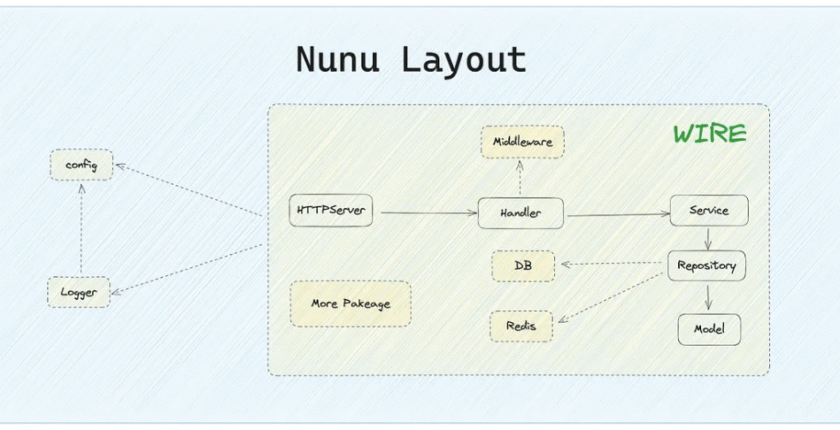The CLI tool to build Golang applications
✨ The CLI tool to build Golang applications
explained
If you are a Golang developer, you know how important there is a reliable and effective application scaffold. This is where Nunu comes. On the name of the Legue of Legends, Nunu is a Cli tool that quickly helps you build the Golang app using famous libraries in the Golang Environmental System.
Gaytap: https://github.com/go-nunu/nunu
Features
Nunu comes with many features that make it a great option to build Golag apps:
Jinn: a famous http web framework
GORM: Power
Wire: dependency injection framework
– Viper: Training Management Library
Zap: Registration Library
–Golag-jwt: JWT Library
-Ge-redis: Redis customer library
Certificate: Test Library
– Sonyflake: A Far Identity Birth of Distribution
-Robfig-cro: Crohn Library
And more …
benefits
Nunu offers many benefits that make it a great option to build Golang applications:
Low learning cost and customization: Nunu envelops famous Golag libraries, making it easy to customize your application to meet the specific needs.
High performance and expansion: Nunu uses the latest technologies and best practices to ensure that the application can deal with high traffic and large quantities of data.
Safe and reliable: Nunu uses stable and reliable third -party libraries to ensure your application safety and reliability.
– My standard and can be expanded: Nunu is designed to be standard and extendable, allowing you to add new features and functions easily.
Full documents and testing: Nunu provides comprehensive documents and examples to help you start quickly. It also includes a set of testing wings to ensure that your application works as expected.
Structure
NUNU adopts classic layer architecture and uses dependency injection framework to achieve the model and separation.
There are no ads to display, please add some
👉 Read more at: Full Article
Hashtags: #CLI #tool #build #Golang #applications
📰 Published by Stefan on 2023-06-23 15:46:00
From: Golang Libraries, Apps, Golang Jobs and Go Tutorials
🔥 The CLI tool to build Golang applications
explained

If you are a Golang developer, you know how important there is a reliable and effective application scaffold. This is where Nunu comes. On the name of the Legue of Legends, Nunu is a Cli tool that quickly helps you build the Golang app using famous libraries in the Golang Environmental System.
Gaytap: https://github.com/go-nunu/nunu
Features
Nunu comes with many features that make it a great option to build Golag apps:
Jinn: a famous http web framework
GORM: Power
Wire: dependency injection framework
– Viper: Training Management Library
Zap: Registration Library
–Golag-jwt: JWT Library
-Ge-redis: Redis customer library
Certificate: Test Library
– Sonyflake: A Far Identity Birth of Distribution
-Robfig-cro: Crohn Library
And more …
benefits
Nunu offers many benefits that make it a great option to build Golang applications:
Low learning cost and customization: Nunu envelops famous Golag libraries, making it easy to customize your application to meet the specific needs.
High performance and expansion: Nunu uses the latest technologies and best practices to ensure that the application can deal with high traffic and large quantities of data.
Safe and reliable: Nunu uses stable and reliable third -party libraries to ensure your application safety and reliability.
– My standard and can be expanded: Nunu is designed to be standard and extendable, allowing you to add new features and functions easily.
Full documents and testing: Nunu provides comprehensive documents and examples to help you start quickly. It also includes a set of testing wings to ensure that your application works as expected.
Structure
NUNU adopts classic layer architecture and uses dependency injection framework to achieve the model and separation.
There are no ads to display, please add some
👉 Read more at: Source
Explore more: #CLI #tool #build #Golang #applications
Written by Stefan on 2023-06-23 15:46:00
From: Golang Libraries, Apps, Golang Jobs and Go Tutorials

